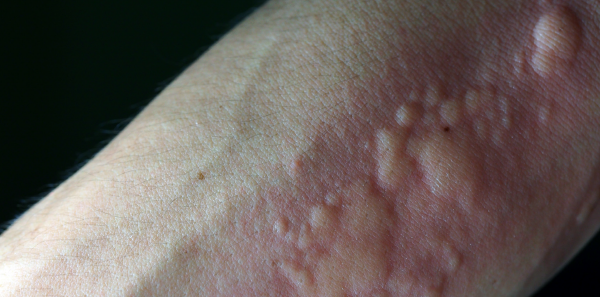
Medical news consumers may have noted the arrival of intravenous cetirizine (Quzyttir). This second-generation “nonsedating” antihistamine was approved by the U.S. Food and Drug Administration (FDA) in October 2019. Since then, its defining trial has been published in the Annals of Emergency Medicine, and promotional material now shows up in some trade magazines.1
Explore This Issue
ACEP Now: Vol 40 – No 06 – June 2021Intravenous cetirizine is precisely what you envision it to be: a 10-mg dose of cetirizine hydrochloride in sodium chloride for injection. Likewise, it operates as expected: selective inhibition of peripheral of H1 receptors. It is currently approved for treatment of acute urticaria, an indication currently treated by off-label use of the remaining family of first- and second-generation antihistamines. However, while it and its second-generation cousins are available in oral formulation, availability for intravenous injection is restricted to diphenhydramine, while hydroxyzine is available for intramuscular use. An intravenous formulation of a selective H1 inhibitor therefore has potential advantages.
The Research
These potential advantages were examined in the aforementioned randomized, double-blind, active-comparator trial conducted in 19 emergency departments and urgent care centers in the United States and Canada.1 This trial enrolled patients with acute urticaria and an elevated “patient-rated pruritis severity score,” comparing 10 mg of intravenous cetirizine with 50 mg of intravenous diphenhydramine. The primary endpoint of the trial was the patient-rated pruritis severity score at two hours following admission. If you are not already familiar with this scoring system, it is likely because it was created specifically by the trial sponsor for the purpose of this trial. This ordinal scale ranges from 0 to 3, in which 0 is “no pruritis,” 1 is “mild,” 2 is “moderate,” and 3 is “severe.” The trial was designed to test for the noninferiority of IV cetirizine compared to diphenhydramine.
The Results
Among 262 patients randomized into roughly similar cohorts, there were ultimately no differences in this patient-reported outcome measure. Each group complained of an average of “moderate” pruritis at baseline, and each displayed similar general declines in symptoms within an hour. Considering the almost identical clinical performance of each drug, the prespecified margin for statistical noninferiority was easily met.
The more interesting clinical information comes from the many secondary outcomes. Diphenhydramine, as a first-generation antihistamine, displays greater sedating and anticholinergic properties. These adverse effects can be particularly undesirable in an elderly population or in people who have to stay alert during the day or at work, for example. To this effect, the authors measured a “patient-rated sedation score” for each group, an ordinal clinical scale defined only in this trial. To little surprise, the sedation perceived by patients receiving diphenhydramine exceeded that of those given intravenous cetirizine. The mean level of sedation rose from baseline to “mild” in those receiving diphenhydramine, while those receiving cetirizine generally remained close to their baseline upon enrollment.
Other key secondary endpoints included physician assessment of urticaria, effectively treated patients, time spent at treatment centers, and short-term recidivism. The results were full of minor curiosities. Even though the patient-rated pruritis scores improved similarly for each intervention, nearly twice as many patients in the diphenhydramine group received a rescue agent of some kind. These agents were most frequently a steroid, whether prednisone, methylprednisolone, or dexamethasone. Then, oddly, despite this excess of patients receiving steroids in the diphenhydramine, short-term recidivism favored cetirizine. The reasons for follow-up visits were not reported, so it is difficult to determine whether these were related to treatment failure or other adverse effects. It is also possible, particularly in a small trial like this, that there are simply unmeasured differences between the groups.
Lastly, the authors focus on time spent at treatment centers, which is distinct from length of stay. This outcome captures the time from treatment administration to discharge rather than from emergency department or urgent care center arrival. Roughly speaking, there was an advantage to intravenous cetirizine of about 20 to 30 minutes over diphenhydramine, which has reasonable face validity. However, this difference was not statistically significant under their prespecified analysis plan, and it was found only in an ad hoc analysis designed after efficacy data were already known.
Pages: 1 2 3 | Single Page




2 Responses to “Does New IV Urticaria Medication Offer Benefits Over Current Treatments?”
July 19, 2021
Dr. Joseph SachterExcellent review — as usual. Although I might use the intravenous preparation a little more frequently than “almost never’ (an unaccompanied patient who drove to themselves to the ED and might otherwise be ready for discharge a couple of hours after treatment initiation), the $300 a dose price is a dealbreaker.
This in turn brings up an interesting economic question. Wouldn’t TerSera (marketers of the drug) make more money overall if they charged less? Best analogy I can think of is a movie theatre charging $5 for a pint of spring water that costs them no more than a dime. Wouldn’t they sell at least five times more if they charged a dollar?
July 20, 2021
Ryan RadeckiI would imagine the price point for Quzyttir was thoughtfully selected from a team of analysts putting together a value-based price – potentially incorporating, perhaps, the revenue gain from reduced ED LOS if the drug were to offer some more rapid discharge, etc.